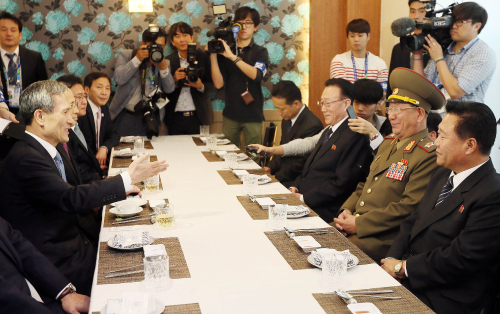 |
|
PARLEY ON THE PENINSULA: South Korea's National Security Advisor Kim Kwan Jin (left) talks with senior North Korean officials Choe Ryong-Hae (right), Hwang Pyong So (second right) and Kim Yang Gon (third right) during a luncheon meeting in Incheon, South Korea, on October 4, 2014 (XINHUA/AFP) |

The state of affairs on the Korean Peninsula is frozen in a stalemate, and the only thing all parties seem to have in common amid the confusion and frustration is a shared inability to break the deadlock. The future direction of the situation on the peninsula may depend on whether positive or negative factors prevail. If an atmosphere of positivity is fostered, then a solution to the crisis will surely emerge. On the contrary, uncontrolled growth of negative factors may lead to a grave crisis.
Heightened negativity
The peninsula is currently undergoing an unfortunate flood of events that are preventing the situation from moving in the right direction. According to reports from Seoul-based Yonhap News Agency, South Korea's Ministry of Defense declared on December 29, 2014 that a trilateral pact to share military intelligence between South Korea, Japan and the United States had taken effect. According to the pact, the three countries will share intelligence on nuclear and missile "threats" posed by North Korea. Though the new agreement appears to be a kind of defensive cooperation, it actually serves to further the hidden purpose of Washington's aggressive push.
The U.S. Department of Defense claimed that the major catalyst for the trilateral intelligence-sharing pact is the rapid development of Pyongyang's missile program. In a military parade in April 2012, North Korea displayed a mock-up of its newly developed KN-08 missile. In its annual report on North Korea's military strength in March 2014, the Pentagon claimed that the firing range of the missile is 5,500 km, putting it in reach to directly threaten the U.S. mainland. Though the report also admitted that the missile has not been tested and cannot be put into real combat by Pyongyang, Washington seized the excuse to push its own strategic deployment in Northeast Asia.
Washington's Northeast Asia strategy consists of two parts--respectively, building a missile defense system gradually in the region and forging a military cooperation mechanism between the United States, South Korea and Japan. The two parts supplement one another in that by building a regional missile defense system, the United States can incorporate Japan and South Korea into its combat system, allowing itself to assert greater control over the two East Asian countries. Meanwhile, creating a trilateral military cooperation mechanism is not only conducive to the operation of the regional missile defense system but also favors Washington's oversight of the regional combat system. In addition, the mechanism restricts the military independence of both Japan and South Korea.
As the three countries negotiated on the intelligence-sharing agreement, the United States deployed its second AN/TPY-2 missile defense radar in Japan's Kyoto Prefecture. The AN/TPY-2 is a kind of transportable X-band, high-resolution, phased-array radar designed specifically for ballistic missile defense. It can transmit data on ballistic missile launches to warships equipped with Aegis air defense systems and ground-based interceptor missile sites. The AN/TPY-2, together with the U.S. ballistic missile early warning radar system, sea-based X-band radar and early-warning satellite system, are the "eyes" of the U.S. missile defense system. With them, the United States can monitor and trace the missile launching activities of all countries in the region.
The United States has dominated the series of actions in the name of missile threats from Pyongyang, with Japan and South Korea acting as its "little brothers." But to focus solely on the Pyongyang's missile program misses a larger point. From a global view of the U.S. missile defense system, it can be concluded that these moves by the United States are parts of its strategy to maintain a strategic edge over the competition between major world powers.
Washington claimed that it refuses to restart talks with Pyongyang due to the latter's unwillingness to give up its nuclear program. However, the preconditions for talks imposed by the United States, which require North Korea to first take steps toward denuclearization and refrain from provocative acts, are the root of the deadlock, suggesting that Washington is not eager to negotiate with Pyongyang.
